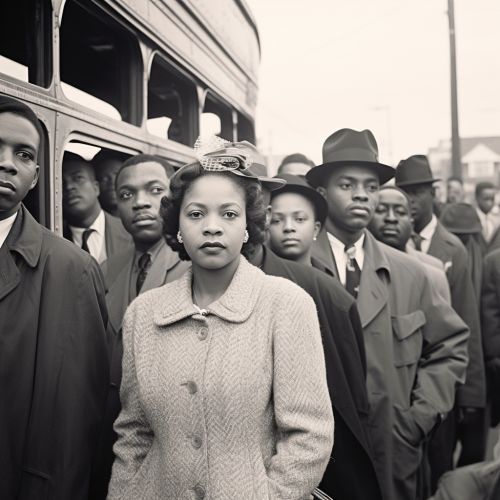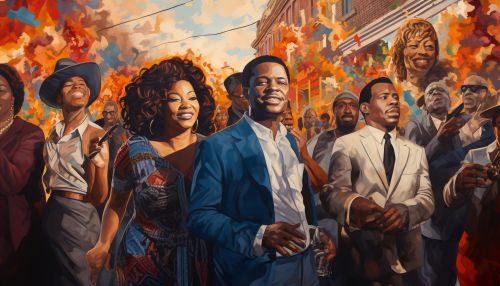Civil Rights Movement
Origins of the Civil Rights Movement
The Civil Rights Movement in the United States was a decades-long struggle by African Americans and their like-minded allies to end institutionalized racial discrimination, disenfranchisement, and racial segregation. The movement has its roots in the Reconstruction era following the American Civil War, where attempts were made to redress the inequities of slavery and its political, social, and economic legacy.


Jim Crow Laws and Early Resistance
The Jim Crow laws, enacted between 1876 and 1965, were state and local laws that enforced racial segregation in the Southern United States. These laws marginalized African Americans by denying them the right to vote, hold jobs, get an education, and other opportunities. Those who attempted to defy Jim Crow norms were often met with violence and death.
In the early 20th century, numerous African Americans and whites organized and led local and national movements to resist and end racially discriminatory practices, such as the National Association for the Advancement of Colored People (NAACP) and the Southern Christian Leadership Conference (SCLC).
Brown v. Board of Education and Massive Resistance
The landmark case Brown v. Board of Education of Topeka, Kansas in 1954 overturned the 'separate but equal' doctrine established by the earlier Plessy v. Ferguson decision. The U.S. Supreme Court's decision sparked outrage among many white Southerners and led to a backlash known as "Massive Resistance", an organized opposition to school desegregation.
Montgomery Bus Boycott and the Rise of Martin Luther King Jr.
The Montgomery Bus Boycott, a seminal event in the Civil Rights Movement, was a political and social protest campaign against the policy of racial segregation on the public transit system of Montgomery, Alabama. The campaign lasted from December 5, 1955—the Monday after Rosa Parks, an African American woman, was arrested for refusing to surrender her bus seat to a white person—to December 20, 1956, when a federal ruling took effect, and led to a United States Supreme Court decision that declared the Alabama and Montgomery laws requiring segregated buses to be unconstitutional.
This event brought to prominence a young pastor named Martin Luther King Jr., who emerged as a leader of the boycott and would go on to become a central figure in the Civil Rights Movement and beyond.


Sit-Ins, Freedom Rides, and Project C
In the late 1950s and early 1960s, nonviolent protests and civil disobedience began to escalate. This included sit-ins, where protesters would sit at segregated lunch counters refusing to leave until they were served, and Freedom Rides, where integrated groups would ride buses into the segregated south to challenge the non-enforcement of the Supreme Court's ruling that segregated public buses were unconstitutional.
Project C, also known as The Birmingham Campaign, was a strategic movement organized by the SCLC to bring attention to the unequal treatment that black Birmingham, Alabama citizens endured. The campaign ran during the spring of 1963, and its confrontations between young black students and white civic authorities eventually compelled the municipal government to change the city's discrimination laws.
March on Washington and the Civil Rights Act
The March on Washington for Jobs and Freedom took place in Washington, D.C., on August 28, 1963. Attended by some 250,000 people, it was the largest demonstration ever seen in the nation's capital, and one of the first to have extensive television coverage. The event is most famous for the "I Have a Dream" speech delivered by Martin Luther King Jr.
The following year, the Civil Rights Act of 1964 was passed, which was a landmark civil rights and labor law in the United States that outlawed discrimination based on race, color, religion, sex, or national origin.
Voting Rights Act and the End of the Civil Rights Movement
The Voting Rights Act of 1965 was another major achievement of the Civil Rights Movement, which prohibited racial discrimination in voting. This legislation resulted in the mass enfranchisement of racial minorities throughout the country, especially in the South.
By the late 1960s, the Civil Rights Movement had begun to fracture, with activists debating the future direction of the movement and disagreeing on the most effective methods for achieving their goals. The movement officially ended in 1968, the same year Martin Luther King Jr. was assassinated.
Legacy and Impact
The Civil Rights Movement has had a lasting impact on United States society, in its tactics, the increased social and legal acceptance of civil rights, and in its exposure of the prevalence and cost of racism.


